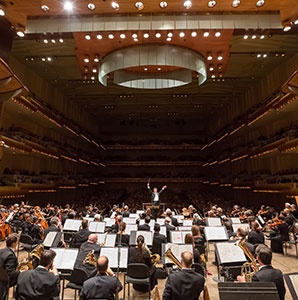 Mark your calendar for these New York events that showcase the best art, dance, music, and theater on view in spring 2014.
Mark your calendar for these New York events that showcase the best art, dance, music, and theater on view in spring 2014.
New York City Ballet: During the 2013–14 season, the ballet company founded by choreographer George Balanchine and Lincoln Kirstein celebrates its 50th anniversary at Lincoln Center in grand style, with performances of 50 ballets. It’s been the NYCB’s home since the New York State Theater (now the David H. Koch Theater) opened in April 1964. George Balanchine’s The Nutcracker, set to Tchaikovsky’s wondrous score, returns November 29, 2013–January 4, 2014. The winter season (January 21–March 2, 2014) features a world premiere by young British choreographer Liam Scarlett as well as Balanchine’s full-length Jewels. Spring (April 29–June 8, 2014) showcases contemporary choreographers Peter Martins, Benjamin Millepied, Alexei Ratmansky, and Christopher Wheeldon, plus a world-premiere collaboration from choreographer and NYCB soloist Justin Peck and singer-songwriter Sufjan Stevens.
The Public Theater: The house that director and arts advocate Joseph Papp built continues as a place of innovation and creativity. In collaboration with the Royal Shakespeare Company and Miami’s GableStage, playwright Tarell Alvin McCraney stages Shakespeare's Antony & Cleopatra, transporting it to the 18th-century Caribbean colony of Saint-Domingue (February 18–March 23, 2014). The Public also hosts the New York premiere of the new musical A Second Chance, by Ted Shen (March 18–April 13, 2014; publictheater.org).
Brooklyn Academy of Music: England’s Glyndebourne Festival Opera brings its staging of Billy Budd, by Benjamin Britten, to the Brooklyn Academy of Music February 7–13, 2014, as part of a citywide centennial celebration marking the composer’s birth.
Broadway: A star-studded cast—Denzel Washington, Diahann Carroll, Anika Noni Rose—anchors the Broadway revival of A Raisin in the Sun at the Barrymore Theatre, opening April 3, 2014 (raisinbroadway.com).
International Center of Photography: Founded in 1974 by Cornell Capa to honor the life and work of his brother Robert—a well-known photojournalist killed in Vietnam—ICP is one of the leading institutions devoted to the evolving medium of photographic art. In 2014, it presents “Capa in Color,” a show of never-before-seen color photographs taken by Capa late in his career (January 31–May 4, 2014; icp.org).
Rubin Museum of Art: The singular focus on the art of the Himalayas at the Rubin Museum inspires some of New York’s most imaginative programming, including spring 2014’s interactive exhibition on Tibetan medicine. The seventh annual Brainwave considers endurance, willpower, and the placebo effect through onstage conversations between scientists and individuals from all walks of life: kung-fu master, sports champion, poker player, firefighter, meditation teacher, and marathon runner.
Frieze New York: What has become the city’s most compelling art fair puts a local spin on the London original: Frieze New York occupies Randall’s Island in the East River and brings together more than 180 international and U.S. galleries under a spacious tent, whose design provides a luminous setting for the art, talks, and discussions (May 9–12, 2014, friezenewyork.com).
Metropolitan Museum of Art: Each spring, the Met’s Costume Institute mounts shows—Alexander McQueen; Prada/Schiaparelli—that have become some of the city’s most anticipated. In 2014, all eyes are on “Charles James: Beyond Fashion,” the inaugural exhibition of the renovated institute, which examines the Anglo-American couturier, whose legendary career encompassed three quarters of the 20th century (May 8–August 10, 2014).
TriBeCa and New York Film Festivals: Of many, two film festivals define New York City: the TriBeCa Film Festival, initiated in 2002, and the long-established New York Film Festival, produced by the Film Society of Lincoln Center. Each spring, the TriBeCa lends focus to New York’s role as a filmmaking center (April 16–27, 2014; tribecafilm.com). The NYFF launches each fall’s cultural season and offers distinctive programming year round. The 2014 calendar includes a series devoted to French and Italian films, the latest screenings from new directors, and Dance on Camera (filmlinc.com).
Studio Museum in Harlem: Focused on artists of African American descent, the Studio Museum in Harlem presents “When Stars Begin to Fall: Imagination and the American South,” interpretations of the region through the work of several generations of artists (March 27–June 29, 2014).
New York Philharmonic: At Avery Fisher Hall at Lincoln Center and venues throughout the city, the New York Philharmonic hosts the inaugural NY Phil Biennial, a festival of contemporary music featuring works by 50 composers from 12 countries—including the U.S premiere of Toshio Hosokawa’s The Raven (nyphil.org).
Metropolitan Opera: Starry tenor Jonas Kaufmann sings the title role in Massenet’s Werther, based on Goethe’s romantic, tragic novel, in a new production, staged by Richard Eyre, at the Metropolitan Opera (February 18–March 15, 2014)—the season’s hot ticket.
Asia Society: This educational nonprofit—now with 11 branches worldwide—got its start in New York in 1956, with a permanent collection that includes statuary, ceramics, and paintings. In 2014, look for “Tales of Wonder: Indian Art from the Asia Society Museum Collection,” which considers the legends of Indian deities in painting and sculpture (February 4–May 4, 2014; asiasociety.org).
Whitney Biennial: This essential survey of global contemporary art at the Whitney covers multiple disciplines and, in 2014, showcases the work of 103 artists. It is organized by three guest curators: Stuart Comer, of the Museum of Modern Art; Anthony Elms, of Philadelphia’s Institute of Contemporary Art; and Michelle Grabner, of the School of the Art Institute of Chicago (March 7–May 25, 2014).